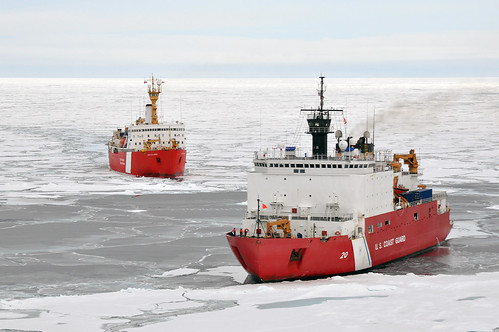 Shipping vessels could be cutting directly through the Arctic by mid-century, as sea ice melts and new routes open up to commercial traffic for the first time in known history, according to a new study from two UCLA scientists. The researchers combined sophisticated climate modelling with northern shipping route information for ships passing from the Pacific to the Atlantic.
Shipping vessels could be cutting directly through the Arctic by mid-century, as sea ice melts and new routes open up to commercial traffic for the first time in known history, according to a new study from two UCLA scientists. The researchers combined sophisticated climate modelling with northern shipping route information for ships passing from the Pacific to the Atlantic.This is the first time such mapping has been done to show how melting sea will open the previously frozen frontier to commercial traffic between the years 2040 and 2059. Their findings were published Monday in the journal Proceedings of the National Academy of Sciences Plus.
"It's both an exciting and worrisome prospect because you're talking tourism, cruise-liners, fishing ships,” said lead researcher Laurence C. Smith. “And as these waters open up the incentive will be there, the motivation will be there to explore them with common ships.”
Smith, a professor of geography at the University of California, Los Angeles and author of "The World in 2050," co-authored the report with Scott R. Stephenson, a Ph.D. candidate at UCLA's geography department.
Key predictions:
- Standard open-water vessels will be able to navigate through the Arctic by mid-century.
- Polar Class 6 vessels, which are strengthened against ice, will be able to take a direct line from the Pacific to the Atlantic by cruising directly over the North Pole -- a route that would be 20 per cent shorter than current routes.
- Canada's treacherous Northwest Passage will become a viable route for Polar Class 6 vessels.
- The Northern Sea Route along the coast of Russia would become navigable for standard ships.
The researchers used the month of September, when Arctic sea ice is typically at its lowest point, as their benchmark for predicting future trends. Using seven different climate models, Smith and Stephenson looked at forecasts that incorporated both medium-low and high increases in carbon emissions, and the corresponding rise in global warming. Interestingly, the result was the same under either model.
"The bottom line is once the ice thins enough, further warming doesn't much matter at least for the Polar Class 6 vessels," Smith said. "And even for the open water vessels the take-home message is the same -- the Northwest Passage opens up half of the time on average, and the Northern Sea Route is fully viable to open water vessels regardless of which climate change scenario you assume."
The predictions, if proven to be true, could result in significant changes to the shipping industry. Today, the Northwest Passage is theoretically navigable only one out of every seven years, making it too unpredictable and dangerous as a shipping route for commercial operations. However, according to the study the route will be open every other year by mid-century, vastly increasing its viability.
That would have political implications as well. While Canada considers the Northwest Passage to be part of its sovereign territory, the U.S. and other nations consider it to be an international strait. However, until now the point has been largely moot because the waterway has been almost entirely unnavigable.
If that were to change, the disagreement could quickly become a sore point between the two nations.
"This study suggests this issue will need to be resolved in the coming years because this route will become viable, especially for light ice breakers and eventually even to open water vessels," Smith said.
If shipping traffic increases in the Arctic, Canada would likely have to increase its presence and patrols in the region as well, he said.
Smith said the modelling shows the Arctic will remain unfriendly to shipping traffic during the winter, and there is no danger that climate change will put the Suez Canal out of business anytime soon.
Source: CTV News
Image courtesy of DVIDSHUB via Flickr (CC BY 2.0)
